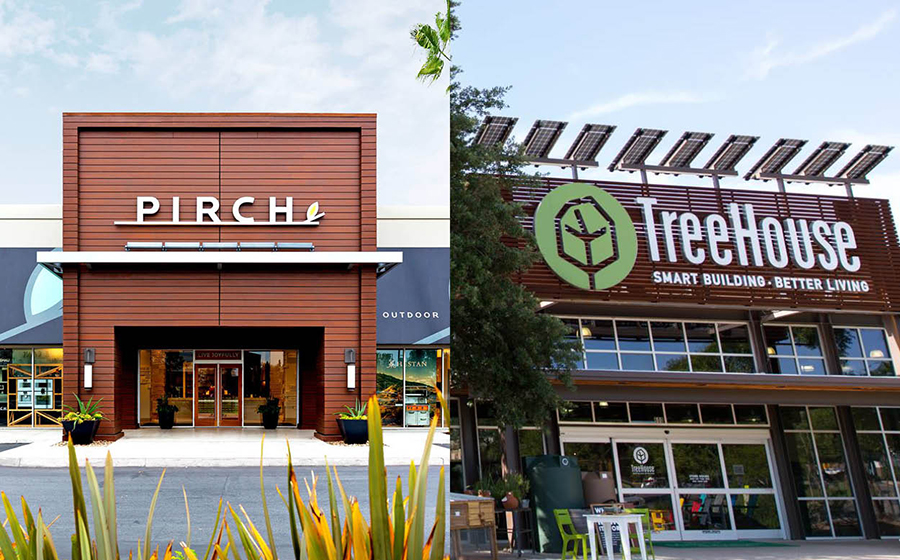Ask any retailing expert, guru or know-it-all worth their weight in consulting fees and they will all tell you the same thing: the future of physical stores rests with \”experiential\” formats that present shoppers with an immersive atmosphere that can\’t be replicated online. But what happens when they are wrong? Over the past year or so, two of the most high-profile new retail startups in the country – Pirch in the kitchen and bath business and TreeHouse which was billed as the green home improvement store — have either shut their doors completely or drastically scaled back their operations. Each was considered by all manner of retail observers (including yours truly) as the poster child for the future of retailing, yet each failed to achieve success. And somewhere in the telling of these two tales lie some lessons for other retailers trying to sort out how to keep all those physical doors open.
Pirch
Of these two operations, Pirch was clearly the larger and more well established, first appearing in 2009 with a single San Diego store, and at its peak, having 10 locations stretching from coast to coast in some of the ritziest zip codes in the country. Its stores, some as large as 30,000-square-feet, featured a fantasyland of kitchen and bath fixtures, appliances and cabinets along with a slim assortment of decorative accessories. Most displays were fully functional to the extent that you could take a bath in one of its spa tubs or cook dinner on a $20,000 range.
And these stores were not out on the highway in some suburban strip center. They were situated in high-rent locations like Soho in Manhattan and The Garden State Plaza Mall in Paramus, NJ next to Neiman Marcus. But by the start of last year Pirch began to shut down many of those stores and eventually it circled the wagons around its four California stores where it all began. Those stores remain open and management and the private equity money players who couldn\’t stop talking about Pirch have basically gone dark these days.
TreeHouse
More modest in scale, with only three stores at its peak – all in Texas – TreeHouse operated on the premise that a home improvement store for the green and sustainable generation had a viable place in the retail world. It opened its first store in Austin in 2011 and expanded into the Dallas metro area in 2017.
Its locations were of various sizes – smaller than Home Depot but larger than Ace Hardware – and featured a new age mix of energy-saving electrical products, solar powered technology like the Tesla Powerwall home battery and all sorts of eco-friendly furnishings. But late last year everything came crashing down when all three stores were closed, and ownership admitted it was time to call it a retail day.
Lessons Learned
While each retailer had similar approaches to creating that all-important experience for shoppers, there were also glaring differences:
- Pirch expanded into new, widely scattered locations while TreeHouse focused on its home state, Texas.
- Pirch went for over-the-top real estate – with corresponding rent rates – while TreeHouse picked more reasonably priced locations.
- And Pirch was particularly high profile in both the investment and media worlds while TreeHouse\’s efforts were decidedly more modest.
But the reasons for their downfalls have some key things in common – and again, it should be noted that Pirch remains in business, albeit with a significantly smaller footprint.
- Perhaps most importantly, the niche markets each retailer went after – high-end luxury kitchen and bath and green home improvement – may just not be large enough to support big retail operations. Those customers may be getting what they need from national retailers with more limited, but acceptable, assortments. With premium prices on premium products, this slice of the market is just too small to allow for dedicated retail operations such as these two stores.
- Retail is still a business based on sales productivity. When Pirch made a sale it was a big one but the majority of people who shopped there were not in the market for $60,000 kitchens. Yet the store offered little in the way of take-with products to accommodate those customers and keep the cash flow humming. TreeHouse looked more like a design showroom than a retail store with large swaths of open space and limited assortments. Sales per-square-foot at both retailers was no doubt dismal.
- Each retailer, to some extent, relied on a business model that called for interior designers and/or contractors to make at least some part of the purchasing decision. Traditional retailers going after that kind of sale have struggled as both of these groups often would rather keep an air of mystery around where they are getting their products from – and more importantly how much they are paying for them. Transparency is not a core value of this process
- And in the end, a good experience does not make a good store. It\’s not enough to amuse, engage and stimulate the intellect of a consumer if they don\’t make a purchase. If you could charge admission like a museum maybe you\’d have a business model that could be sustained. But while warehouse clubs have essentially co-opted that strategy it\’s never been translated elsewhere in general retailing.
The failure of these experience-based retailers should serve as fair warning for other companies looking to reimagine the retail paradigm. Allowing shoppers to sleep on your mattresses, cook on your appliances and watch products being made – all tactics being talked about or tested today – won\’t be enough if they don\’t result in somebody buying something. As retailers struggle to keep physical stores relevant, open and, most importantly, profitable, the concept of experience needs to be understood better in the context of the business in general. A bad experience is still an experience, but that doesn\’t mean it\’s good retailing.
Warren Shoulberg loved Pirch and TreeHouse…and said so to anybody who asked. He was right that they were good places to visit but wrong that they were good businesses.




